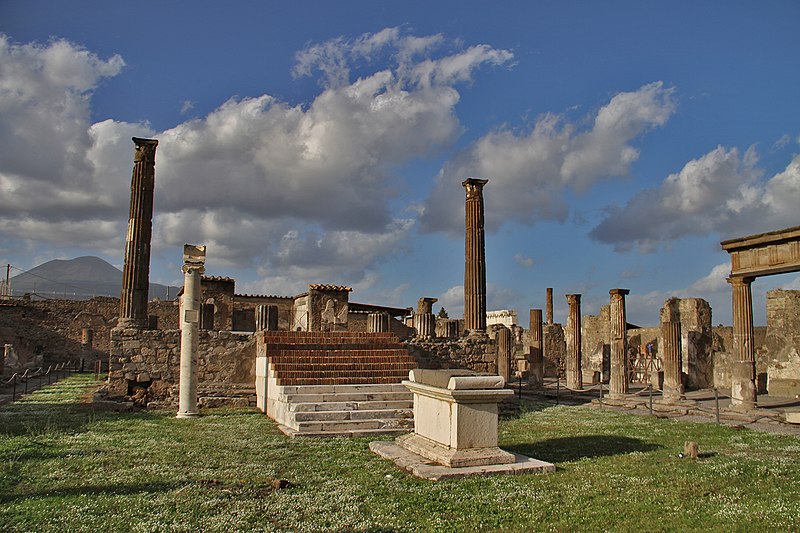Basic Principals of the Roman Religion
I have just finished reading John Scheid’s book, An Introduction to Roman Religion. The book covers many aspects of this ancient religion, but for this blog post I would like to discuss the ideas presented in the first few chapters
The Temple of Apollo in Pompeii. Mount Vesuvius is to the far left. Uploaded by Markos90 Wikipedia Commons https://commons.wikimedia.org/wiki/File:Pompei_5058.jpg
One of the most important principles is that it is
non-dogmatic. There is no orthodoxy. Although it would not make sense for an
atheist to practice these rituals, Roman pagans did and still do hold many
different ideas of who and what the Gods and Goddesses are. And although modern
Romans hold the texts that survive from ancient Rome in high esteem because of
what they can tell us about Roman society and religion, they are not considered
to be revealed texts in the same way that Christians hold the Bible. Instead,
they are respected because of what they can tell us about the ancient practice
of the religion. In this, they are largely consistant. The Roman religion is
orthopraxic. What matters is that the rituals are carried out correctly. It is
a traditionalist religion but is also open to new ideas and new Gods from the
various regions the Romans interacted with and/or conquered. Although Roman
rituals were to be carried out a certain way, Romans were free to view the
world and the Gods in any way they wished. Romans were also free to worship
whatever Goddesses or Gods they wanted, even if they were outside of the Roman
pantheon.
The religious obligations of individuals had to do with which families they belonged to, whether or not they were citizens, and the occupation and social status of individuals. If one’s social status changed, their religious obligations would change as well. “There was in fact no such thing as ‘Roman religion’, only a series of Roman religions, as many Roman religions as there were Roman social groups” (Scheid, 19). It was a social religion. There was no moral code. The religion was not aimed at the salvation of the individual, rather for the well-being of the community. Although the Gods can and do help individuals, they help those individuals as members of the community. This aspect is worth further investigation. Most modern Cultores are practicing as solitaries, and although may be members of online groups, are most likely the only members of their real-world communities who practice this religion. I believe that being a member of a group is important, and I would recommend the Roman Republic http://romanrepublic.org/ and the Cultus Deorum Facebook group. Sometimes I have questioned the practice of praying and offering sacrifices on behalf of my family, which are not pagan, but that is the traditional practice. They have not objected to it, however. Traditionaly, this responsibility was to be carried out by the head of the household. I fulfil this responsibility as the only member of my household that follows this tradition. I myself have asked for help, for example, getting into school, finding a job, etc. As a librarian, I do want to help my community, and try to frame it in that way, but I ask for these things as an individual, not as a member of a community. Ideally, there would be enough Cultores in a given area to form a small community and to carry out these rituals.
And finally, it was a polytheistic religion. The Romans also had slightly different definitions of religious terms than modern Christians do. The term religio, often translated as religion, was defined by Cicero as "scrupulous or strict observance of the traditional cultus". It had to do with cultivating the correct social relationship with the Gods by celebrating the proper rituals. Scheid defines other terms including superstitio, which was an irrational fear of the Gods and slavish behavior to win their favor. Sacer, sacrum referred to ownership. Something that is sacer belongs to a God or Goddess Anything that is not sacer is profanes. Something that is Religiosus is marked by death. Something that is Sanctus (holy) is something that is a religious offense to violate. Piety had to do with proper relationships and attitudes between people as well as the Gods. Impiety was the opposite of piety
The rest of the book describes how this religion was practiced in Rome, in ancient times, when the majority of free citizens were cultores. When this path is large enough where we can start building temples and having public rituals, the information we have on the ancient Roman religion will be invaluable. Modern Romans follow the Numa tradition, so there is no blood sacrifice. The book describes the parts of a Roman temple and what there function is. How Romans organized time, and the various festivals that took place during the year. Scheid describes how the Romans would carry out a sacrifice, and the different parts of a ritual. And finally, he summarized how the Romans themselves interpreted their religion.
This is a dense academic book and is not light reading. However, if one is serious about following this tradition, this should be required reading. My next book on my reading list is De Natura Deorum, (On the Nature of the Gods) By Cicero.

No comments:
Post a Comment